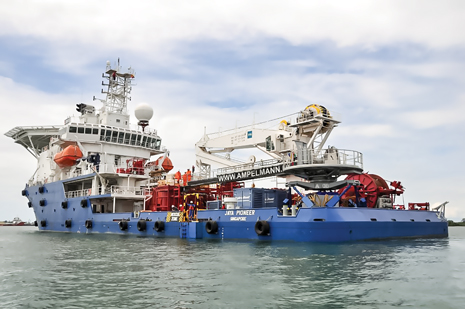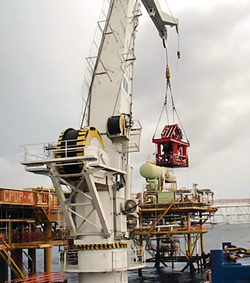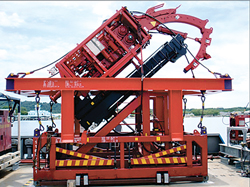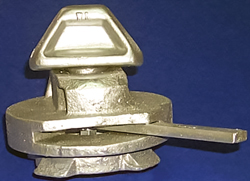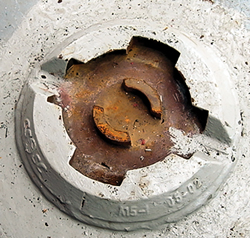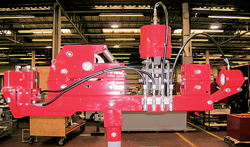First well interventions by a full-catenary CT system on a DP vessel with compensated gangway
An offshore operator in Brunei faced the challenge of increasing the injectivity in waterflooded fields, to improve hydrocarbon production. The solution chosen to achieve the injection targets involved the use of a stimulation vessel with coiled tubing (CT), nitrogen and the pumping capability to perform well interventions. The operation faced challenging offshore weather conditions, limited platform access, a lack of crane facilities and an aging offshore infrastructure. It also had to provide an emergency disconnect system, while simultaneously improving operational efficiency. The stimulation vessel was used in conjunction with some new concepts employed in the offshore CT operation. These included the use of a full-catenary system for CT operations, a dynamic positioning (DP) vessel, a knuckle-boom crane and a heave-compensated gangway. The full-catenary system was selected for the CT operation to minimize lifting hazards, improve equipment installation lead times, and improve the operational efficiency of the stimulation vessel. The DP vessel eliminated anchoring requirements; it also provided enhanced efficiency for both evacuation and approach to offshore facilities. The knuckle-boom crane provided the capability to lift equipment, at a variety of angles. For example, the crane had the ability to lift equipment, which was located in difficult positions, such as underneath a platform helideck. The heave-compensated gangway facilitated the safe transfer of personnel, between the stimulation vessel and the offshore facilities. It also provided a safe emergency response and evacuation facility, in the event of sudden severe weather, a platform emergency or worsening sea conditions. The advantages and benefits of utilizing these concepts, for offshore operations, have resulted in a significant improvement in both operational efficiency and safety for the stimulation vessel. BACKGROUNDOperations were performed offshore, in the West Brunei Darussalam waterflooded oil field. The field’s average sea depth is approximately 30 m, and it sits approximately 70 km northeast of Seria. The field holds 40% of Brunei’s known reserves and produces around 100,000 bopd. The field already has more than 260 wells, which were drilled from 40 platforms. A central field complex has living quarters for about 160 personnel. It is also equipped with gas lift and compression capabilities, and water injection facilities. Waterflooding is a significant factor supporting the field’s hydrocarbon production levels, so, to increase production, improvements needed to be made to the water injection process. NEW CONCEPT STIMULATION VESSELDynamic positioning vessel. The well intervention stimulation vessel is newly built. It is equipped with a DP Class 2 system, which includes anti-roll tanks and a computerized ballast-control system. The vessel is designed to operate throughout the year, in the seasonal weather that is typical of Southeast Asian waters. On the coastal waters off Borneo Island, typically in Brunei Darussalam, the significant wave height during the monsoon period, which runs from November to February, is approximately 3.5 m. Throughout the rest of the year, the wave height is between 0.5 and 2.5 m, depending on the occurrence of storms offshore, whereby the significant wave height can reach 3.5 to 4.0 m. Dynamically positioned vessels are capable of responding to drastically changing weather conditions, by helping ensure that the DP system interprets environmental data and allows the operator to hold or change the vessel’s position accordingly. This capability allows the vessel to maintain position, and remain on station, at a safe distance from an adjacent platform, while performing intervention operations. Typically, a “DP footprint” exists of the distance that the vessel operates from within a central axis of itself. Each DP vessel has referencing systems, depending on the operator and/or end-user requirements. The vessel discussed in this work has several referencing systems. This provides redundancy, so that the DP system computer can ascertain the vessel’s exact location, as well as the magnitude and direction of environmental forces affecting its position. Should a change in position be detected by the computer, based on the parameters provided by the referencing system, the DP computer will provide automatic command signals, to the propulsion systems, to increase or decrease thrust and guide the direction of the thrusters (in the case of azimuth thrusters), until the desired set location and/or direction is achieved. This is performed without operator intervention. A DP operator is, however, fully aware of what the system is doing while he, or she, is monitoring both the operation and the system. Another advantage of a DP vessel is that mooring anchors are not required to maintain the vessel’s position; this prevents the need for anchor handling/towing vessels, which are required to lay mooring anchors. Generally, DP vessels are faster, and safer, when approaching offshore platforms and well jackets. The vessel discussed in this article had four DP referencing systems to help ensure that, should any issues arise with a particular type of system, it would not negatively affect the rest of the referencing systems. The referencing systems that are used on this vessel are discussed below.
Knuckle-boom crane. The crane was used for lifting the CT equipment required on the platform for full-catenary operations, Fig. 1. The advantages of the knuckle-boom crane include:
Auto-compensated gangway. This system is a vessel-based, self-stabilizing platform that actively compensates for all vessel motion, to provide safe offshore access to the platforms. The system reduces gangway rig-up time, eliminates the potential hazards associated with transfer by boat and reduces operating downtime, attributed to environmental conditions. The gangway platform actively compensates the wave-induced motions of the vessel, in six degrees of freedom, by individually actuating each of its six hydraulic cylinders. Also, a flexible, telescoping access bridge (gangway) was installed on top of the auto-compensated gangway platform, to passively compensate for any remaining motion and also extend the gangway to the landing position. To transfer personnel, the gangway is lowered to the vessel deck, and the personnel transfer to the gangway platform. The operator will then adjust the gangway platform, to the required height and pitch, and extend the telescoping gangway to the landing area. The end of the telescoping gangway maintains a contact force on the landing structure, at all times. The gangway operator will then signal that it is safe for an individual to cross. Once all personnel are transferred, the telescoping gangway is retracted and stowed on the vessel. Emergency evacuation drills, including stretcher cases, were performed and included in the vessel's emergency response plans. CT and pumping unit with full-catenary system. The stimulation vessel was originally designed to minimize the quantity of CT equipment transferred onto the production platforms. This design allows work to be performed on smaller platforms with limited deck space. It reduces rig-up time and lifting hazards, and it also avoids overloading the platform structure. An added safety benefit is that, because no engine-operated equipment is placed on the platform, a potential ignition source is eliminated. CT, nitrogen and pumping equipment. A complete set of CT, nitrogen, pumping and acid blending equipment was installed on the vessel, to provide all CT well intervention capabilities. To further reduce the number of lifts to the platforms, a redesigned lifting frame was built, which allowed the injector, and the Hyster injector jacking frame, to be lifted as one unit. The single-lift design saves vessel deck space. A sub base, with ISO locks, was added to the Hyster frame, to secure it to the vessel during transport. These ISO locks were also the attachment points for the casters, which were used for positioning the injector once on the platform. A support was designed to go between the injector frame and the Hyster jacking frame, to take some of the weight of the injector while in the transport mode. The lifting frame is removed once the injector is on the platform, Fig. 2.
Equipment’s sea fastening. The stimulation vessel used ISO locks to secure all equipment to the vessel deck—instead of the traditional methods of using chain and boomers or welding equipment to the deck. Because some of the equipment had the same footprint, the use of ISO locks provided more flexibility in equipment placement; it also facilitated change-out, in the event that repairs were necessary. The empty, raw acid tanks and liquid nitrogen tanks were easily replaced, with full ones, between jobs, using this system. Most of the equipment used on the vessel had ISO blocks built in. For equipment without built-in ISO locks, sub-frames were added. The ISO lock system consisted of the ISO blocks, the lock and the lower mounting section. The ISO locks work by installing the lock into the lower mounting section, which is welded to the deck. Next, the equipment with ISO blocks is set down onto the lock, a lever is turned, and the equipment is locked to the deck. The lower mounting section ISO lock welds were all magnetic particle-inspected (MPI), before the stimulation vessel was put into operation. ISO locks have long been used in the shipping container industry; they provide a safe and secure method of attaching equipment, Figs. 3 and 4.
The ISO blocks provided an additional benefit. They acted as an attachment point for the hydraulic lift casters, which were used to move the lifting frame onto the platform deck. Once the casters were installed, a hydraulic hand pump was used to raise the Hyster frame off the deck, making it easier to move. Full-catenary system. The system is designed, so that the CT power pack, control cabin, and pumping and mixing equipment remain on the vessel. The only equipment lifted to the platform is the CT injector, tubing guide and pressure-control equipment. Additional flowback equipment can be positioned on the platform, depending on the job requirements. Two video cameras are installed on the platform. The display monitor, which is in the control cabin, allows the CT operator to observe what is happening on the platform, at all times. The following equipment forms an emergency disconnect system, which can be activated if the vessel must pull away from the platform in an emergency:
All hoses from the platform are equipped with recovery slings, which allow for quick retrieval, so that operations can be resumed as quickly as possible. A Koomey unit was also placed on the platform, to operate the safety BOP, in the event that an emergency disconnect from the platform was required. Well control. Once the CT is cut at the reel, and the vessel pulls away, well control is maintained by means of external barriers, the BOP and Koomey system, and internal barriers, and the double flapper check valves in the CT string. Once conditions allow the resumption of CT and stimulation activities, the CT can be rejoined using double-ended connectors. All hydraulics hoses can be retrieved and reconnected for operations. Job results. Acid stimulation jobs were performed from the stimulation vessel, delivering more than expected, in terms of injection rates achieved, Figs. 6 and 7.
CONCLUSIONSA stimulation vessel was used in conjunction with some new concepts to perform a successful CT operation offshore, providing the following advantages:
|
- Applying ultra-deep LWD resistivity technology successfully in a SAGD operation (May 2019)
- Adoption of wireless intelligent completions advances (May 2019)
- Majors double down as takeaway crunch eases (April 2019)
- What’s new in well logging and formation evaluation (April 2019)
- Qualification of a 20,000-psi subsea BOP: A collaborative approach (February 2019)
- ConocoPhillips’ Greg Leveille sees rapid trajectory of technical advancement continuing (February 2019)

